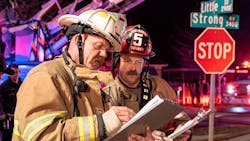Despite all of the changes in the fire service over the past decades, the one thing that has remained unchanged is the need for leadership.
Characteristics of a successful officer
The addition of a shiny new badge and helmet and a forward-facing seat is just the beginning of the promotion to company officer or battalion chief. The test occurs when all eyes look to you for a decision, for how you handle a difficult situation or for how you lead into a structure fire.
Whether you just are beginning your role as a supervisor or are a seasoned person in charge, the Seven Cs can help to confirm that the course that you are on is correct or to identify that you must reroute some of your leadership philosophies.
During my 33 years in the fire service, I have been led by some top-notch leaders and by some who weren’t so good. I combined the best of what they taught me and what I did as a company officer and battalion chief into the seven qualities that will secure a solid foundation for a fire service leader.
Consistency
Consistency is one of the most important qualities for a new leader.
The first day with a new crew/shift calls for some type of orientation and discussion of what’s expected of them. Officers must choose wisely what to list as expectations, because if the expectations aren’t adhered to, the officer will be forced to react with some type of response or disciplinary action. If no action is taken, officers stand the chance of creating an environment that has “bark” but no “bite” and of losing the respect of those who they lead.
Setting expectations also can be tricky when a new leader has a senior crew that’s well-seasoned or has a “difficult” member of the crew.
It also can be challenging when officers ask crew members not to do something that the officers have a reputation of doing. For example, officers who are known to show up right before the shift starts can have a difficult time insisting that others show up ahead of the start of the shift to prepare for the start of the day.
On the other hand, officers who are in the gym regularly and try to eat right might have an easier time getting crew members to work out/eat healthfully.
Showing up to work with a positive attitude every day goes a long way, because the crew won’t have to guess an officer’s “mood of the day.”
Compassion
Company officers and battalion chiefs who truly care about their members (and their members’ families) develop a crew attitude that will have the members “run through a brick wall” for their supervisor. Sometimes, it really is as simple as listening to someone talk about their child’s Little League game, a vacation, a birthday that’s coming up or a house project; it doesn’t have to be fire department related.
Also, encouraging and helping someone to reach a career goal or promotion shows that you care about their career. Mentoring someone and allowing them to move up on the truck in an acting supervisor role under your direction are examples.
Officers can empower their crew to make decisions at appropriate times, such as planning the daily schedule or training topics or leading a public talk. It gives members some ownership in the process. (The fireground isn’t the time for a vote on what to do.)
When crew members know that an officer supports them and cares about them, trust in the officer begins. At the same time, officers must extend their trust to the members. This improves crew retention, happiness, and the relationship between the officer and the members.
Confidence
The first few fires that new company officers or battalion chiefs go on probably have them shaking in their boots, but their crew must know that they can trust the officer’s decisions and that the officer possesses the command presence to stand tall in the heat of the battle. That said, new officers are bound to make mistakes. Dealing with those situations honestly and admitting errors while working to correct them through training goes a long way.
The administration also must have belief in the supervisor that the overall department objectives and mission statement of the organization will be met.
If you can perform your job in a way that creates a positive public image, if you do your job consistently (without continuous supervision) and if you provide a positive outcome for the customer (internally and externally), your worth will go up.
Complacency (or lack of)
One of the best ways to prevent complacency is to lead by example. It’s kind of cliché, but it’s all too true. This might be difficult with a crew that already developed bad habits with their former company officer or battalion chief.
This is where officers’ previous reputation as a good firefighter comes in handy.
Furthermore, changing bad habits takes training and education.
Complacency doesn’t show up on a specific day but slowly enters people’s routines if allowed. It’s an action that follows the path of least resistance until it becomes an acceptable part of operations. Every time that officers allow complacency, it becomes more the norm, until it comes up to bite you or a crew member.
Supervisors should say something immediately if they see an unsafe or inappropriate behavior on the part of their crew. If not, that omission itself should be considered complacent.
Culture
During one’s career, you will be exposed to many experiences and different cultural values that will mold your leadership skills and shape your responses to daily situations. To improve on your department’s culture, you first must understand the current status or set of beliefs that define it. For example, does your department recognize fair and equal treatment of its membership? Does it promote safety to reduce firefighter deaths?
To successfully influence any changes as an individual, leaders must treat their crew(s) with integrity and a set of core ethics as their foundation.
Although a fire department, as a whole, develops a culture based on the cumulative actions and beliefs of its members, each station and crew has its own unique culture.
Commitment
As leaders, commitment means being dedicated to your department’s mission and values, to the citizens who you serve, to the fire service tradition, to your crew and to the motivation that sparked your interest to promote. The role of a leader demands that you stay focused every day. When on duty, leaders can’t afford to take a day off, because there is just too much at stake in keeping your crew safe. They have a family to go home to.
Some stretches of shifts can be tedious, with the repetition of the “normal” types of calls. However, we all know that the big one can happen at any moment. Being committed to training, ethics, physical fitness and daily routine prior to that moment pays dividends and creates a feeling of pride in a job well done.
Courage
Here lies perhaps the most powerful characteristic that leaders can possess. All of the other traits mean little if leaders don’t have the courage to do the right thing, either physically or mentally. It takes physical courage to tactically lead a crew into a well-involved burning building and moral courage to do what you believe to be right even at the risk of the consequences from your peers.
As leaders, the decisions that you will make never will make everybody happy, but you can’t be everyone’s friend. When a problematic situation arises, you can be sure that others are watching to see how you handle it. Whatever happens to your crew, you will own it. Negligence or not knowing isn’t an OK excuse.
You can anticipate some challenging situations, and sometimes the stakes are high, but these also are opportunities to grow and to gain the respect and trust of the firefighters who you lead.
Through turbulent times
Our profession is different from almost all other types of jobs, except maybe the military, so it makes sense for fire department leaders to reflect that distinctive style of work and the type of people who perform it. It takes someone who can contribute as a professional day in and day out, who can provide mentorship and be an inspiration to those who follow.
Leadership isn’t always plainly visible. It can be accomplished subtly, but it is required and expected. When it’s absent, it’s extremely visible.
The Seven Cs can help you to man the helm in stormy weather and keep your leadership values on course.
About the Author

Gibby Gorman
Gibby Gorman recently retired from his fire service career after nearly 33 years, which began in 1986 with the Tempe, AZ, Fire and Medical Department, where he served for 27 years. During that time, Gorman: worked as a downtown ladder captain for 14 years; responded on the SCUBA Rescue Team; worked on the hazmat team; served as coordinator for the Regional Technical Rescue Teams; taught fire science classes at the community college level; and presented ladder tactics for Firehouse World conferences,, including in 2020. In 2013, he became a battalion chief for the Maricopa, AZ, Fire and Medical Department. Gorman created Southwest Firefighting Concepts. He received his bachelor’s degree from Arizona State University.
